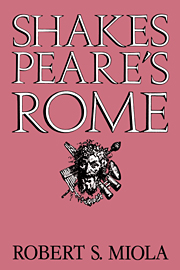Book contents
- Frontmatter
- Contents
- Acknowledgments
- Notes on sources
- I The roads to Rome
- II The Rape of Lucrece: Rome and Romans
- III Titus Andronicus: Rome and the family
- IV Julius Caesar: Rome divided
- V Antony and Cleopatra: Rome and the world
- VI Coriolanus: Rome and the self
- VII Cymbeline: Beyond Rome
- VIII Conclusion
- Index
I - The roads to Rome
Published online by Cambridge University Press: 28 October 2009
- Frontmatter
- Contents
- Acknowledgments
- Notes on sources
- I The roads to Rome
- II The Rape of Lucrece: Rome and Romans
- III Titus Andronicus: Rome and the family
- IV Julius Caesar: Rome divided
- V Antony and Cleopatra: Rome and the world
- VI Coriolanus: Rome and the self
- VII Cymbeline: Beyond Rome
- VIII Conclusion
- Index
Summary
Shakespeare's conception of ancient Rome has long been a focal point in the larger debate concerning his classical learning. This debate began in earnest with Jonson's notorious aphorism imputing to Shakespeare “small Latine, and lesse Greeke” (1623), but hints of it appear earlier. The first printed allusion to Shakespeare, Robert Greene's attack on the “vpstart Crow, beautified with our feathers” (1592), expressed the indignation of a university man at the pretensions of a less-educated rival. And in The Return from Parnassus, Part 2 (performed ca. 1600, pub. 1606), William Kemp humorously praised Shakespeare for outdoing those who “smell too much of that writer Ouid, and that writer Metamorphosis, and talke too much of Proserpina & luppiter” The debate, ably documented elsewhere, continued throughout the centuries and attracted luminaries to both sides. In 1664, for example, Margaret Cavendish, Duchess of Newcastle, admired the verisimilitude of the Roman plays, where fancy, it seemed, almost outworked nature:
& certainly Julius Caesar, Augustus Caesar, and Antonius, did never Really Act their parts Better, if so Well, as he hath Described them, and I believe that Antonius and Brutus did not Speak Better to the People, than he hath Feign'd them; nay, one would think that he had been Metamorphosed from a Man to a Woman, for who could Describe Cleopatra Better than he hath done.
Others, including John Dennis and Richard Farmer, noted inaccuracies, collected anachronisms, and scoffed. The controversy goes on in our century. In 1952 a classicist, J. A. K. Thomson, reviewed the evidence and concluded solemnly that Shakespeare was “no scholar.”
- Type
- Chapter
- Information
- Shakespeare's Rome , pp. 1 - 17Publisher: Cambridge University PressPrint publication year: 1983



